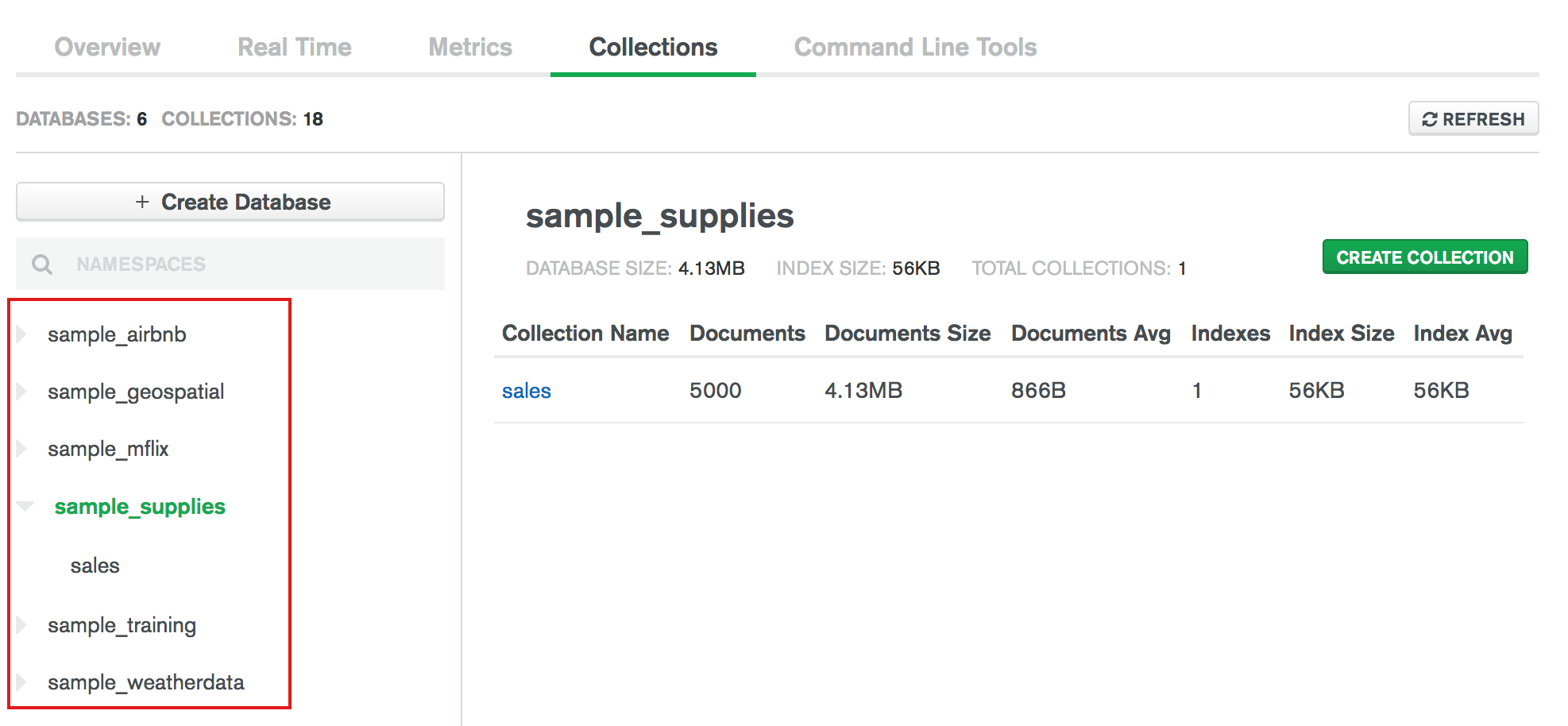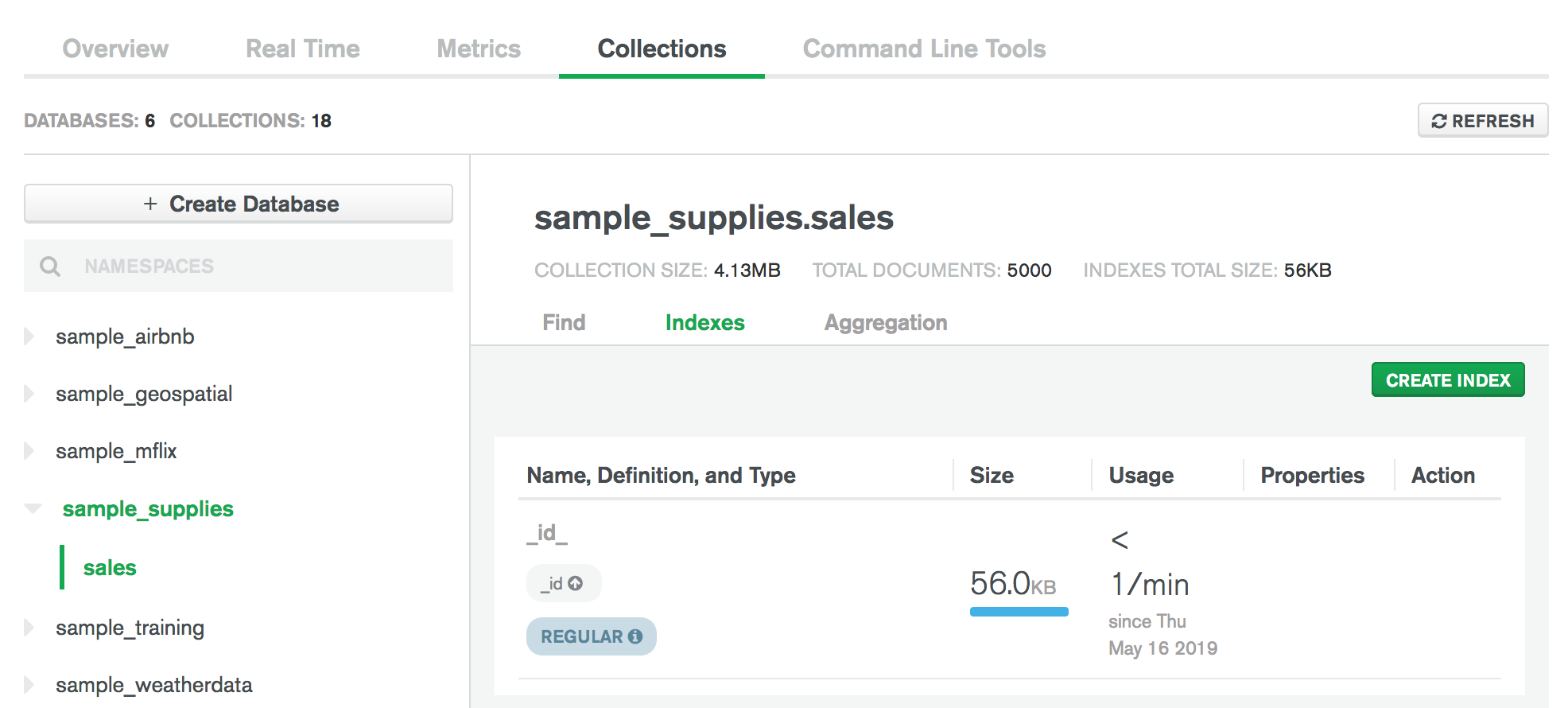Create, View, and Drop Indexes
You can use the Atlas UI to manage indexes on your collections.
Indexes support the efficient execution of queries in MongoDB and should be considered for fields which your application reads often. To learn more about creating effective indexes, see Indexing Strategies.
Required Roles
To create or drop indexes, you must have access provided by at least one of the following roles:
View Indexes
From the Collections tab, you can view index information for a collection. To view index information for a collection:
Create an Index
When you create indexes, keep the ratio of reads to writes on the target collection in mind. Indexes come with a performance cost, but are more than worth the cost for frequent queries on large data sets. Before you create an index, review the documented indexing strategies.
You can build full-text search with Atlas Search. Atlas Search offers fine-grained text indexing. To learn more, see Review Atlas Search Index Syntax.
To create an index for a collection through the Atlas UI:
Click Create Index.
In the Create Index modal, enter the index key specification document:
{ <field1>: <index type>, ... }
To create a compound index on the fields category
(ascending order) and score (descending order), specify the
index specification document:
{ category: 1, score: -1 }
To learn more about indexes, see Indexes.
(Optional) Specify the index options.
When you create an index, you can specify a variety of index options.
Examples:
- For partial indexes, specify the partialFilterExpression option.
- For sparse indexes, specify the sparse option.
- For TTL indexes, specify the expireAfterSeconds option.
- For 2d Indexes, specify the options for 2d Indexes
{ <option1>: <value1>, ... }
The following options document specifies the unique option and
the name for the index:
{ unique: true, name: "myUniqueIndex" }
You cannot perform a rolling build for a unique index. If you
enable building indexes in a rolling fashion with the
unique index option, Atlas rejects your configuration
with an error message.
(Optional) Set the Collation options.
Use collation to specify language-specific rules for string comparison,
such as rules for lettercase and accent marks. The
collation document
contains a locale field which indicates the ICU Locale code, and may contain other
fields to define collation behavior.
The following collation option document specifies a locale value
of fr for a French language collation:
{ "locale": "fr" }
To review the list of locales that MongoDB collation supports, see the list of languages and locales. To learn more about collation options, including which are enabled by default for each locale, see Collation in the MongoDB manual.
(Optional) Enable building indexes in a rolling fashion.
Rolling index builds succeed only when they meet certain conditions. To ensure your index build succeeds, avoid the following design patterns that commonly trigger a restart loop:
- Index key exceeds the index key limit
- Index name already exists
- Index on more than one array field
- Index on collection that has the maximum number of text indexes
- Text index on collection that has the maximum number of text indexes
the Atlas UI does not support building indexes with a rolling build
for M0 free clusters and M2/M5 shared clusters. You
can't build indexes with a rolling build for
serverless instances.
Building indexes in a rolling fashion reduces the performance impact of building indexes on replica sets and sharded clusters.
To maintain cluster availability:
- Atlas removes one node from the cluster at a time starting with a secondary.
- More than one node can go down at a time, but Atlas always keeps a majority of the nodes online.
Atlas automatically cancels rolling index builds that do not succeed on all nodes. When a rolling index build completes on some nodes, but fails on others, Atlas cancels the build and removes the index from any nodes that it was successfully built on.
In the event of a rolling index build cancellation, Atlas generates an activity feed event and sends a notification email to the project owner with the following information:
- Name of the cluster on which the rolling index build failed
- Namespace on which the rolling index build failed
- Project containing the cluster and namespace
- Organization containing the project
- Link to the activity feed event
To learn more about rebuilding indexes, see Build Indexes on Replica Sets.
The following index options are incompatible with building indexes in a rolling fashion:
If you specify any of these options in the Options pane, Atlas rejects your configuration with an error message.
Drop an Index
To drop an index from a collection through the Atlas UI:
You cannot delete the _id index. To learn more, see
Unique Indexes.

